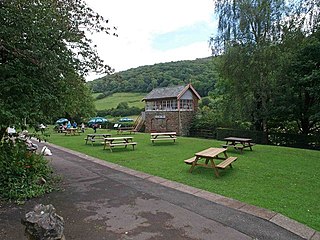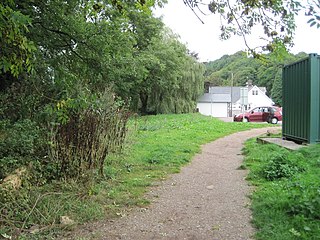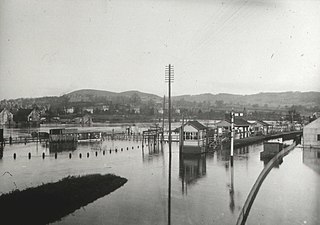
Perrygrove Railway is a heritage railway of 15 in gauge. It is located at Perrygrove Farm in the Forest of Dean, near Coleford, Gloucestershire, England. Trains travel at frequent intervals on a round trip of 1+1⁄2 miles (2.4 km) between four stations. Passengers can ride on the train to use activities including a Treetop Adventure, a covered picnic and play area at Foxy Hollow, an Indoor Village with secret passages, and a den-building area in the woods.

The Severn and Wye Railway began as an early tramroad network established in the Forest of Dean to facilitate the carriage of minerals to watercourses for onward conveyance. It was based on Lydney, where a small harbour was constructed, and opened its line to Parkend in 1810. It was progressively extended northwards, and a second line, the Mineral Loop was opened to connect newly opened mineral workings.

Coleford Great Western Railway Museum is a railway museum located in Coleford, Gloucestershire, England. The museum was founded in 1988. Based in the former GWR Goods Shed along the Coleford Railway. There was also another station situated at Coleford, it was opened by the Severn and Wye Railway. The Museum traces the history of all the railways in the Forest of Dean, Gloucestershire from the early 19th century when the first plateways were laid, to the 1970s when the Dean Forest Railway was founded. The Museum has information about the Wye Valley Railway, Severn & Wye Railway and Monmouth Troy railway station.

The Wye Valley Railway was a standard gauge railway that ran for nearly 15 miles (24 km) along the Lower Wye Valley between the towns of Chepstow and Monmouth, crossing several times between Wales and England. Opened on 1 November 1876, it was leased to, and worked by, the Great Western Railway (GWR), before being fully absorbed by the GWR in 1905.

Monmouth Troy was one of the two former railway stations at Monmouth. It was built in 1857 by the Coleford, Monmouth, Usk and Pontypool Railway and was used by several other branch lines as the local rail network expanded. The station closed in January 1964 following the closure of the last two lines to the station, the Wye Valley Railway and the Ross and Monmouth Railway.
The Coleford Railway was a railway company that constructed a short railway from near Monmouth to Coleford, close to the Forest of Dean. The company was sponsored by the Great Western Railway. It was built on part of the course of the Monmouth Railway, a horse-operated plateway, and it was intended that its primary business would be the conveyance of minerals and forest products from the Forest of Dean.
Tidenham Station was the station for the village of Tidenham on the former Wye Valley Railway. It was opened in 1876 during the construction of the line and closed on 5 January 1959 following the closure of the line to passenger services. The next station on the line was Netherhope Halt.

Tintern railway station served the village of Tintern on the Wye Valley Railway. It was opened in 1876 and closed for passengers in 1959 and freight in 1964, when the line was closed completely. It was the second largest station on the line, the most substantial being Monmouth Troy railway station.
Brockweir Halt was a request stop on the former Wye Valley Railway. It was opened to the public on 19 August 1929. It closed in 1959 when passenger services were withdrawn from the line. It was situated just north of Brockweir bridge. Nothing now remains of the trackbed because of the realignment of the A466.
Llandogo Halt was a request stop on the former Wye Valley Railway. It was opened on 9 March 1927 to serve the village of Llandogo. It was closed in 1959 following the withdrawal of passenger services on the line. It was the smallest construction on the Wye Valley Railway.

St Briavels Station was a station along the Wye Valley Railway. It was built in 1876 during the construction of the line on the Monmouthshire side of the River Wye at Bigsweir, and was intended to serve the nearby villages of St Briavels, across the river in the Forest of Dean, and Llandogo, which is further down the Wye Valley. It was closed on 5 January 1959 when the line was closed to passenger services.
Whitebrook Halt was a request stop on the former Wye Valley Railway. It was opened in 1927 to serve the village of Whitebrook. It was closed in 1959 when passenger services were withdrawn from the Wye Valley Railway. The station came too late to make full use out of the village's industry. Whitebrook had once been home to three paper mills. However, paper making ceased in Whitebrook in the early 1880s, only four years after the line opened in 1876. The halt was not built until long after the closure of the paper mills.

Penallt Halt was a request stop on the former Wye Valley Railway. It was opened on 1 August 1931 and closed in 1959. Penallt Halt and Redbrook Station were the closest stations on the line with only Penallt Viaduct separating them. Penallt Halt was close to the village of Redbrook.

Redbrook on Wye railway station was a station serving the village of Redbrook on the now disused Wye Valley Railway. It was opened on 1 November 1876 with the rest of the line and remained open for 83 years, it closed in 1959. The sidings and passing loop remained open until late 1961 to serve the Tinplate Works in the village.

Monmouth Mayhill railway station is a disused railway station on the Ross and Monmouth Railway which was opened in 1873 and closed in 1959. It was one of two stations that served the town of Monmouth, Wales and was situated on the opposite bank of the river River Wye from Monmouth. It was the initial terminus of the line, but the line was extended across the River Wye to the junction station of Monmouth Troy in 1874 with the construction of the Duke of Beaufort Bridge.
Lydbrook Junction railway station is a disused railway station in England opened by the Ross and Monmouth Railway in 1873, it remained open for 91 years until 1964 when the line finally closed to freight, though passenger services ceased in 1959. The station was constructed in the hamlet of Stowfield approximately half a mile from Lydbrook and its viaduct on the Severn and Wye Railway. It was located approximately 4 miles and 34 chains along the railway from Ross-on-Wye station. In 1874 the Severn and Wye Railway opened a branch from Serridge Junction and Cinderford, passenger services commenced in 1875. All passenger trains along the S&W branch were withdrawn from 1929.
Monmouth Troy Goods Yard was a large goods yard near Monmouth Troy railway station in Monmouth, Wales. It was opened in 1857 by the Coleford, Monmouth, Usk and Pontypool Railway at the same time as the station. As other railways reached Monmouth Troy the goods yard grew in importance. At its height, the goods yard was used by the Wye Valley Railway, Coleford Railway, Ross and Monmouth Railway as well as the Coleford, Monmouth, Usk and Pontypool Railway. The goods yard closed in 1964 when the last two railways, the former Wye Valley Railway and Ross and Monmouth Railway, closed. The non-rail depot remained open until October 1964.

Tintern Quarry was a quarry in the Forest of Dean, Gloucestershire, England. It was served by the Wye Valley Railway from 1876 until it closed in 1981. The quarry was on the opposite side of the River Wye from the village of Tintern.
The Monmouth Railway, also known as the Monmouth Tramroad, was a horse-drawn plateway of 3 ft 6in gauge. It ran for about 5 miles (8.0 km) from Howler's Slade, east of Coleford, in Gloucestershire and Monmouth; there were two branches from other mineral sites. It was intended to bring mineral products of the Forest of Dean to Monmouth, and to the works alongside the River Wye.
Coleford railway station is one of two former stations that served the town of Coleford, Gloucestershire, England. The station was the northern terminus of the former Severn and Wye Railway. The station opened in 1879 and was closed in 1924 to passengers due to lack of passenger use. The line remained in use for goods traffic until the line was closed from Whitecliff Quarry to Coleford in 1967.










